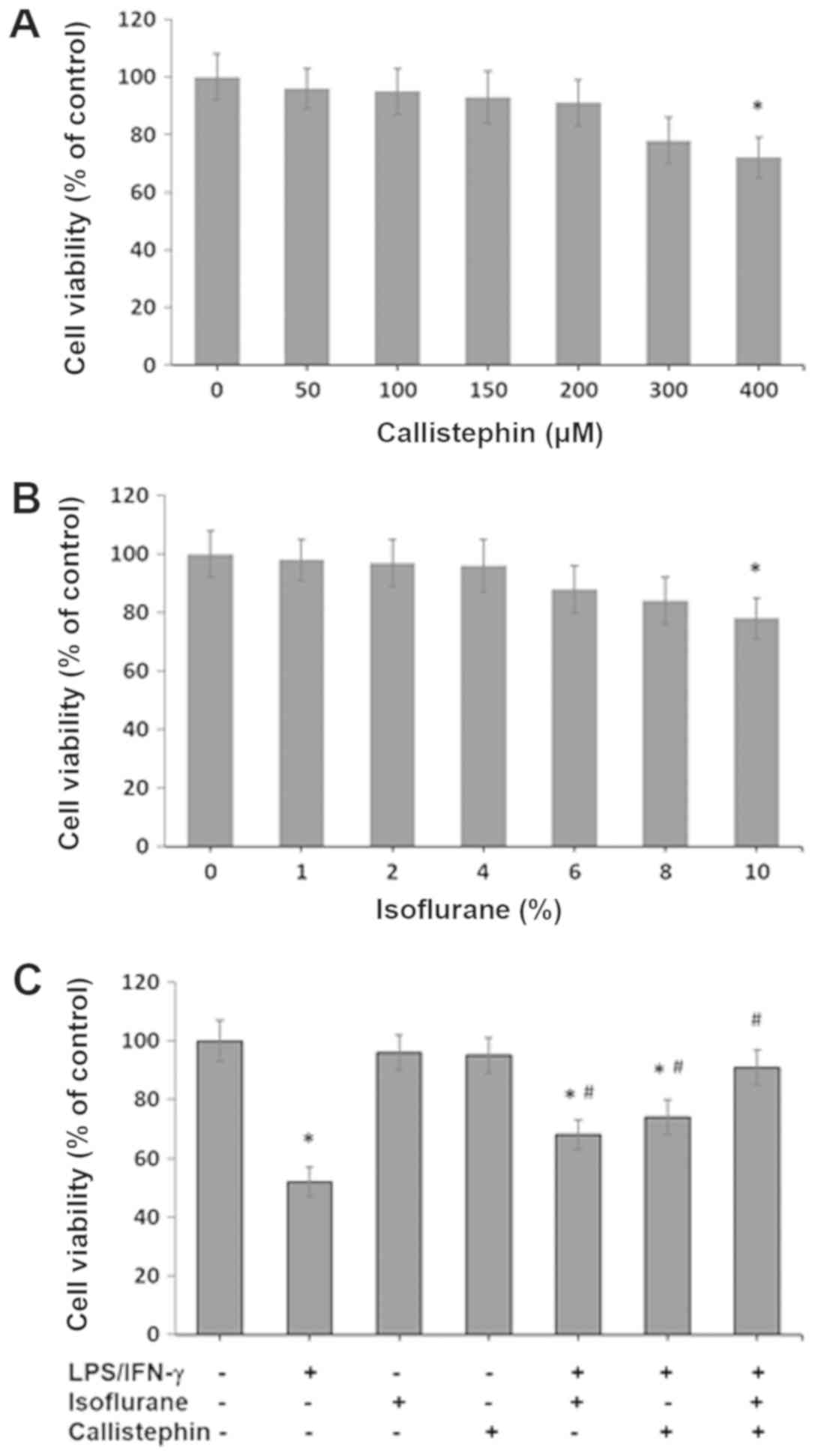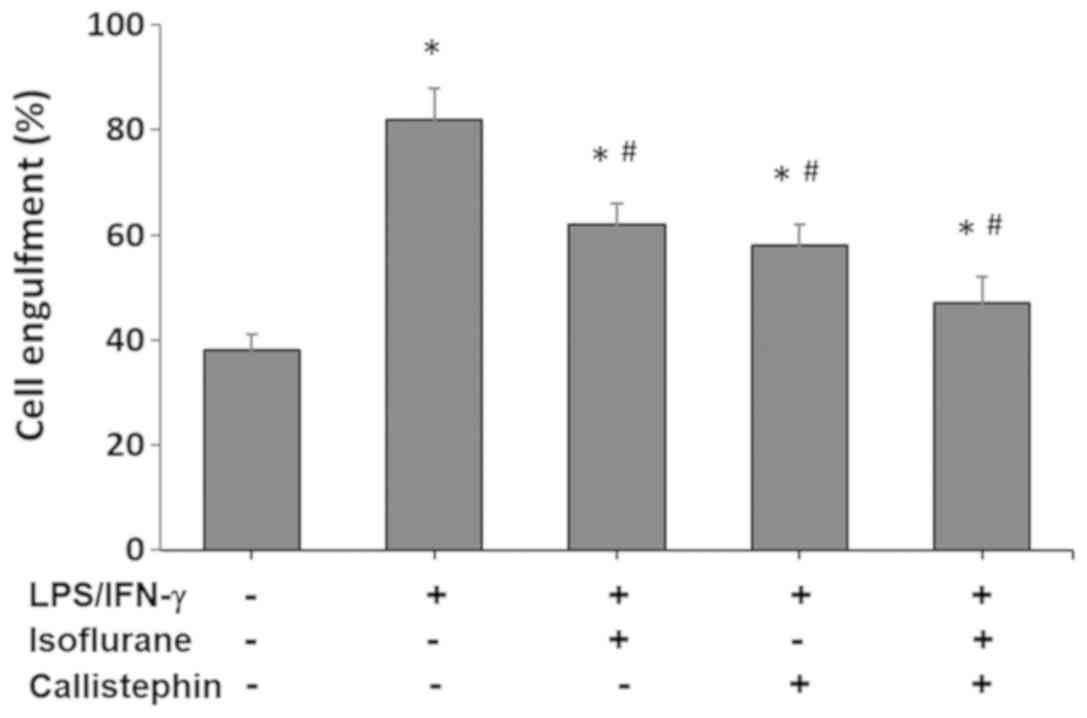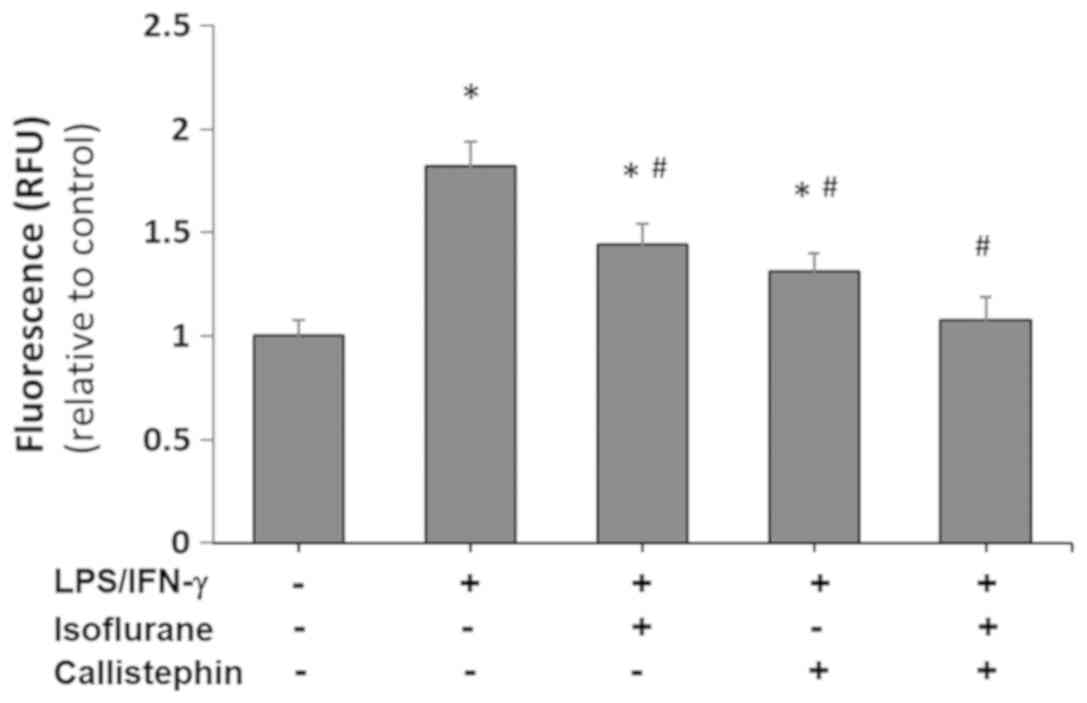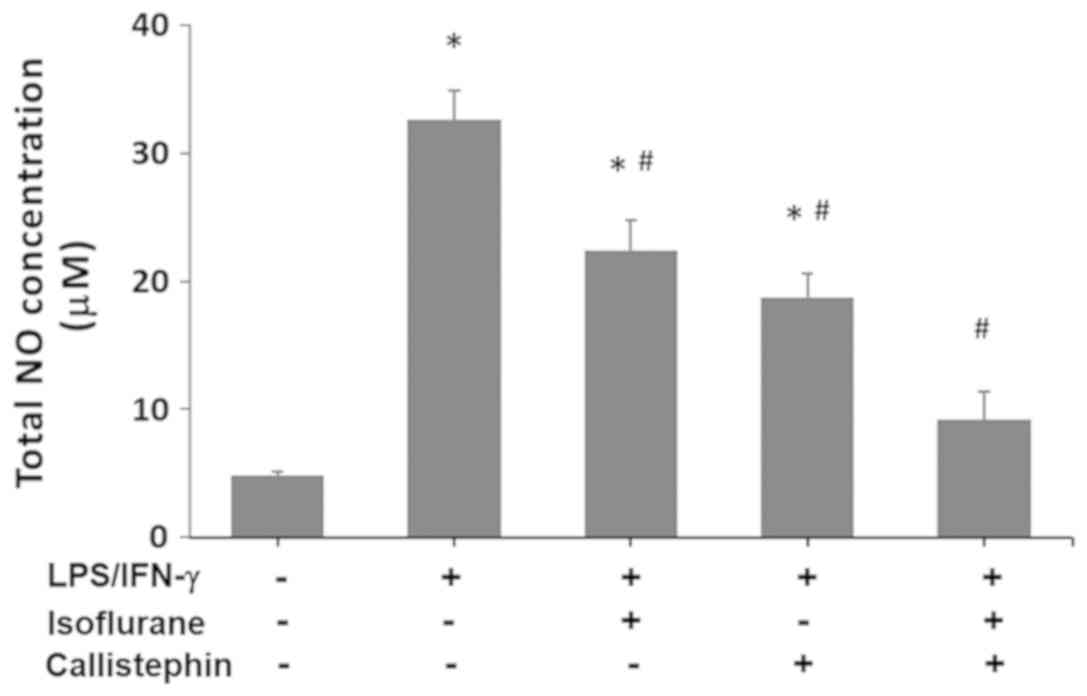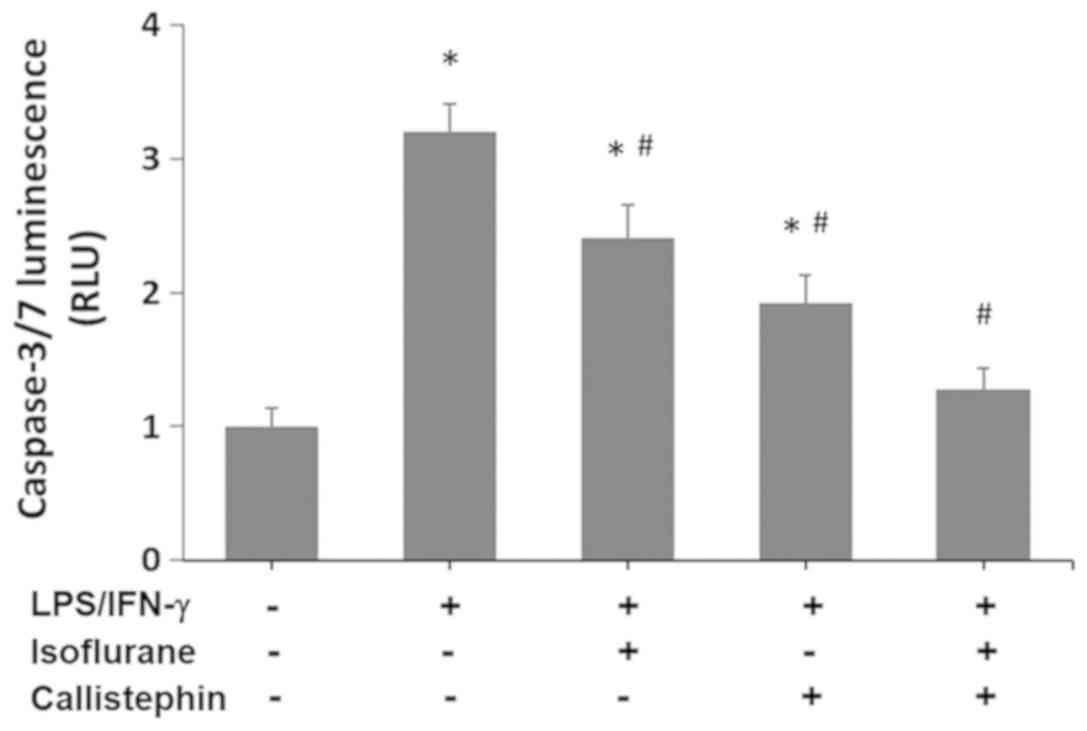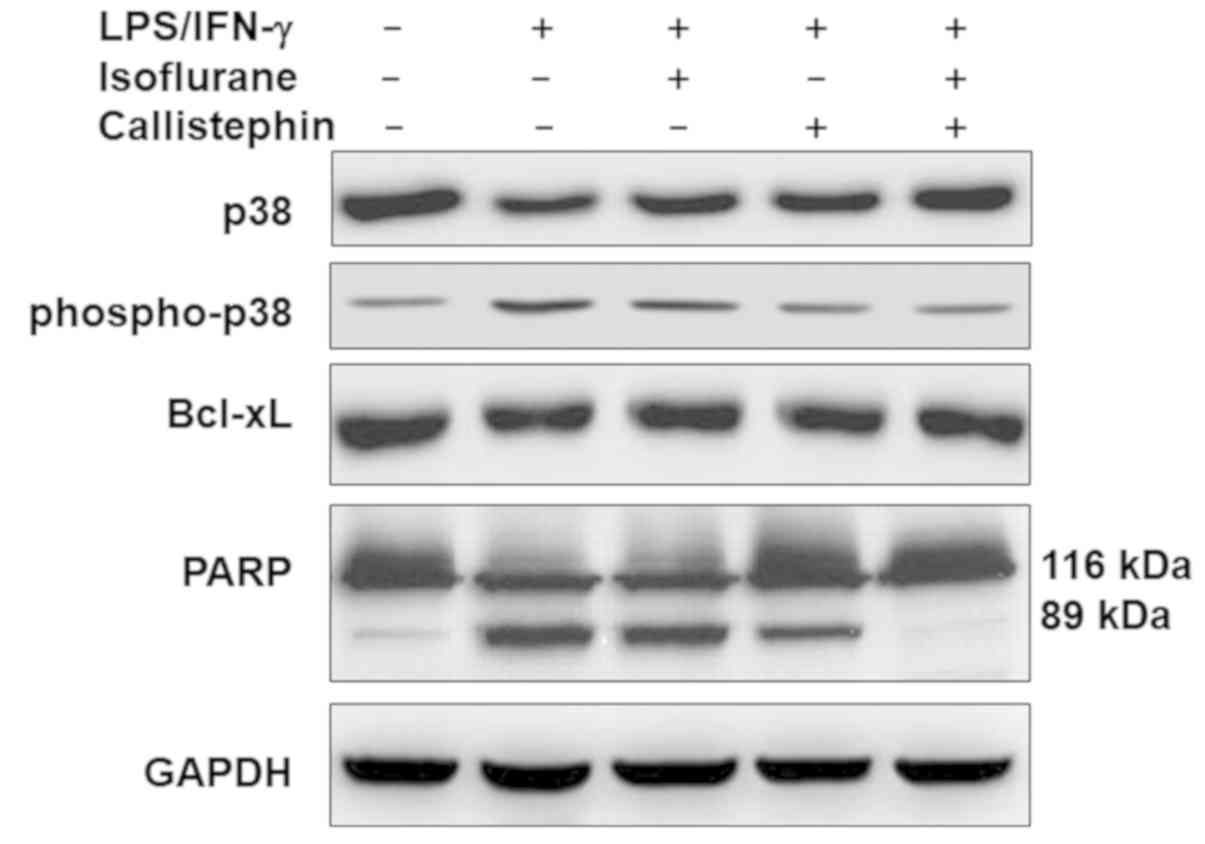|
1
|
Hanisch UK and Kettenmann H: Microglia:
Active sensor and versatile effector cells in the normal and
pathologic brain. Nat Neurosci. 10:1387–1394. 2007. View Article : Google Scholar : PubMed/NCBI
|
|
2
|
Butovsky O, Landa G, Kunis G, Ziv Y,
Avidan H, Greenberg N, Schwartz A, Smirnov I, Pollack A, Jung S and
Schwartz M: Induction and blockage of oligodendrogenesis by
differently activated microglia in an animal model of multiple
sclerosis. J Clin Invest. 116:905–915. 2006. View Article : Google Scholar : PubMed/NCBI
|
|
3
|
Poon IK, Hulett MD and Parish CR:
Molecular mechanisms of late apoptotic/necrotic cell clearance.
Cell Death Differ. 17:381–397. 2010. View Article : Google Scholar : PubMed/NCBI
|
|
4
|
Lucin KM and Wyss-Coray T: Immune
activation in brain aging and neurodegeneration: Too much or too
little? Neuron. 64:110–122. 2009. View Article : Google Scholar : PubMed/NCBI
|
|
5
|
Sierra A, Abiega O, Shahraz A and Neumann
H: Janus-faced microglia: Beneficial and detrimental consequences
of microglial phagocytosis. Front Cell Neurosci. 7:62013.
View Article : Google Scholar : PubMed/NCBI
|
|
6
|
Kim JA, Li L and Zuo Z: Delayed treatment
with isoflurane attenuates lipopolysaccharide and interferon
gamma-induced activation and injury of mouse microglial cells.
Anesthesiology. 111:566–573. 2009. View Article : Google Scholar : PubMed/NCBI
|
|
7
|
Xu X, Kim JA and Zuo Z: Isoflurane
preconditioning reduces mouse microglial activation and injury
induced by lipopolysaccharide and interferon-gamma. Neuroscience.
154:1002–1008. 2008. View Article : Google Scholar : PubMed/NCBI
|
|
8
|
Hara M, Kai Y and Ikemoto Y: Propofol
activates GABAA receptor-chloride ionophore complex in dissociated
hippocampal pyramidal neurons of the rat. Anesthesiology.
79:781–788. 1993. View Article : Google Scholar : PubMed/NCBI
|
|
9
|
Kochs E, Hoffman WE, Werner C, Thomas C,
Albrecht RF and Schulte am Esch J: The effects of propofol on brain
electrical activity, neurologic outcome, and neuronal damage
following incomplete ischemia in rats. Anesthesiology. 76:245–252.
1992. View Article : Google Scholar : PubMed/NCBI
|
|
10
|
Hans P, Bonhomme V, Collette J, Albert A
and Moonen G: Propofol protects cultured rat hippocampal neurons
against N-methyl-D-aspartate receptor-mediated glutamate toxicity.
J Neurosurg Anesthesiol. 6:249–253. 1994. View Article : Google Scholar : PubMed/NCBI
|
|
11
|
Daskalopoulos R, Korcok J, Farhangkhgoee
P, Karmazyn M, Gelb AW and Wilson JX: Propofol protection of
sodium-hydrogen exchange activity sustains glutamate uptake during
oxidative stress. Anesth Analg. 93:1199–1204. 2001. View Article : Google Scholar : PubMed/NCBI
|
|
12
|
Grasshoff C and Gillessen T: The effect of
propofol on increased superoxide concentration in cultured rat
cerebrocortical neurons after stimulation of N-methyl-d-aspartate
receptors. Anesth Analg. 95:920–922. 2002. View Article : Google Scholar : PubMed/NCBI
|
|
13
|
O'Shea SM, Wong LC and Harrison NL:
Propofol increases agonist efficacy at the GABA(A) receptor. Brain
Res. 852:344–348. 2000. View Article : Google Scholar : PubMed/NCBI
|
|
14
|
Yano T, Nakayama R and Ushijima K:
Intracerebroventricular propofol is neuroprotective against
transient global ischemia in rats: Extracellular glutamate level is
not a major determinant. Brain Res. 883:69–76. 2000. View Article : Google Scholar : PubMed/NCBI
|
|
15
|
Burchell SR, Dixon BJ, Tang J and Zhang
JH: Isoflurane provides neuroprotection in neonatal hypoxic
ischemic brain injury. J Investig Med. 61:1078–1083. 2013.
View Article : Google Scholar : PubMed/NCBI
|
|
16
|
Khan KS, Hayes I and Buggy DJ:
Pharmacology of anaesthetic agents II: Inhalation anaesthetic
agents. Cont Edu Anaes Crit Care Pain. 14:601–611. 2014.
|
|
17
|
Zhou Y, Lekic T, Fathali N, Ostrowski RP,
Martin RD, Tang J and Zhang JH: Isoflurane posttreatment reduces
neonatal hypoxic-ischemic brain injury in rats by the
sphingosine-1-phosphate/phosphatidylinositol-3-kinase/Akt pathway.
Stroke. 41:1521–1527. 2010. View Article : Google Scholar : PubMed/NCBI
|
|
18
|
Zhao DA, Bi LY, Huang Q, Zhang FM and Han
ZM: Isoflurane provides neuroprotection in neonatal hypoxic
ischemic brain injury by suppressing apoptosis. Braz J Anesthesiol.
66:613–621. 2016. View Article : Google Scholar : PubMed/NCBI
|
|
19
|
Chung IS, Kim JA, Kim JA, Choi HS, Lee JJ,
Yang M, Ahn HJ and Lee SM: Reactive oxygen species by isoflurane
mediates inhibition of nuclear factor κB activation in
lipopolysaccharide-induced acute inflammation of the lung. Anesth
Analg. 116:327–335. 2013. View Article : Google Scholar : PubMed/NCBI
|
|
20
|
Harr JN, Moore EE, Stringham J, Wohlauer
MV, Fragoso M, Jones WL, Gamboni F, Silliman CC and Banerjee A:
Isoflurane prevents acute lung injury through ADP-mediated platelet
inhibition. Surgery. 152:270–276. 2012. View Article : Google Scholar : PubMed/NCBI
|
|
21
|
Kinoshita H, Matsuda N, Iranami H, Ogawa
K, Hatakeyama N, Azma T, Kawahito S and Yamazaki M: Isoflurane
pretreatment preserves adenosine triphosphate-sensitive K(+)
channel function in the human artery exposed to oxidative stress
caused by high glucose levels. Anesth Analg. 115:54–61. 2012.
View Article : Google Scholar : PubMed/NCBI
|
|
22
|
Kim M, Kim M, Kim N, D'Agati VD, Emala CW
Sr and Lee HT: Isoflurane mediates protection from renal
ischemia-reperfusion injury via sphingosine kinase and
sphingosine-1-phosphate-dependent pathways. Am J Physiol Renal
Physiol. 293:F1827–F1835. 2007. View Article : Google Scholar : PubMed/NCBI
|
|
23
|
Lang XE, Wang X, Zhang KR, Lv JY, Jin JH
and Li QS: Isoflurane preconditioning confers cardioprotection by
activation of ALDH2. PLoS One. 8:e524692013. View Article : Google Scholar : PubMed/NCBI
|
|
24
|
Moyer RA, Hummer KE, Finn CE, Frei B and
Wrolstad RE: Anthocyanins, phenolics, and antioxidant capacity in
diverse small fruits: Vaccinium, rubus, and ribes. J Agric Food
Chem. 50:519–525. 2002. View Article : Google Scholar : PubMed/NCBI
|
|
25
|
Mishra SK and Kim MK: Vitamin A and cancer
risk. Vitamin A and Carotenoids: Chemistry, Analysis, Function and
Effects. The Royal Society of Chemistry; London: pp. 485–500. 2012,
View Article : Google Scholar
|
|
26
|
Yeh CT and Yen GC: Induction of apoptosis
by the Anthocyanidins through regulation of Bcl-2 gene and
activation of c-Jun N-terminal kinase cascade in hepatoma cells. J
Agric Food Chem. 53:1740–1749. 2005. View Article : Google Scholar : PubMed/NCBI
|
|
27
|
Hou DX: Potential mechanisms of cancer
chemoprevention by anthocyanins. Curr Mol Med. 3:149–159. 2003.
View Article : Google Scholar : PubMed/NCBI
|
|
28
|
Domitrovic R: The molecular basis for the
pharmacological activity of anthocyans. Curr Med Chem.
18:4454–4469. 2011. View Article : Google Scholar : PubMed/NCBI
|
|
29
|
Wang CJ, Wang JM, Lin WL, Chu CY, Chou FP
and Tseng TH: Protective effect of Hibiscus anthocyanins against
tert-butyl hydroperoxide-induced hepatic toxicity in rats. Food
Chem Toxicol. 38:411–416. 2000. View Article : Google Scholar : PubMed/NCBI
|
|
30
|
Ramirez-Tortosa C, Andersen ØM, Cabrita L,
Gardner PT, Morrice PC, Wood SG, Duthie SJ, Collins AR and Duthie
GG: Anthocyanin-rich extract decreases indices of lipid
peroxidation and DNA damage in vitamin E-depleted rats. Free Radic
Biol Med. 31:1033–1037. 2001. View Article : Google Scholar : PubMed/NCBI
|
|
31
|
Tsuda T, Horio F and Osawa T: Absorption
and metabolism of cyanidin 3-O-beta-D-glucoside in rats. FEBS Lett.
449:179–182. 1999. View Article : Google Scholar : PubMed/NCBI
|
|
32
|
Youdim KA, Martin A and Joseph JA:
Incorporation of the elderberry anthocyanins by endothelial cells
increases protection against oxidative stress. Free Radic Biol Med.
29:51–60. 2000. View Article : Google Scholar : PubMed/NCBI
|
|
33
|
Tsuda T, Horio F and Osawa T: The role of
anthocyanins as an antioxidant under oxidative stress in rats.
Biofactors. 13:133–139. 2000. View Article : Google Scholar : PubMed/NCBI
|
|
34
|
Lin MT and Beal MF: Mitochondrial
dysfunction and oxidative stress in neurodegenerative diseases.
Nature. 443:787–795. 2006. View Article : Google Scholar : PubMed/NCBI
|
|
35
|
Turner C and Schapira AH: Mitochondrial
dysfunction in neurodegenerative disorders and ageing. Adv Exp Med
Biol. 487:229–251. 2001. View Article : Google Scholar : PubMed/NCBI
|
|
36
|
Heo HJ and Lee CY: Strawberry and its
anthocyanins reduce oxidative stress-induced apoptosis in PC12
cells. J Agric Food Chem. 53:1984–1989. 2005. View Article : Google Scholar : PubMed/NCBI
|
|
37
|
Tarozzi A, Merlicco A, Morroni F, Franco
F, Cantelli-Forti G, Teti G, Falconi M and Hrelia P: Cyanidin
3-O-glucopyranoside protects and rescues SH-SY5Y cells against
amyloid-beta peptide-induced toxicity. Neuroreport. 19:1483–1486.
2008. View Article : Google Scholar : PubMed/NCBI
|
|
38
|
Tarozzi A, Morroni F, Hrelia S, Angeloni
C, Marchesi A, Cantelli-Forti G and Hrelia P: Neuroprotective
effects of anthocyanins and their in vivo metabolites in SH-SY5Y
cells. Neurosci Lett. 424:36–40. 2007. View Article : Google Scholar : PubMed/NCBI
|
|
39
|
Matsunaga N, Imai S, Inokuchi Y, Shimazawa
M, Yokota S, Araki Y and Hara H: Bilberry and its main constituents
have neuroprotective effects against retinal neuronal damage in
vitro and in vivo. Mol Nutr Food Res. 53:869–877. 2009. View Article : Google Scholar : PubMed/NCBI
|
|
40
|
Rice-Evans CA, Miller NJ and Paganga G:
Structure-antioxidant activity relationships of flavonoids and
phenolic acids. Free Radic Biol Med. 20:933–956. 1996. View Article : Google Scholar : PubMed/NCBI
|
|
41
|
Ma H, Johnson SL, Liu W, DaSilva NA,
Meschwitz S, Dain JA and Seeram NP: Evaluation of polyphenol
anthocyanin-enriched extracts of blackberry, black raspberry,
blueberry, cranberry, red raspberry, and strawberry for free
radical scavenging, reactive carbonyl species trapping,
anti-glycation, anti-β-amyloid aggregation, and microglial
neuroprotective effects. Int J Mol Sci. 19:E4612018. View Article : Google Scholar : PubMed/NCBI
|
|
42
|
Rahman MM, Ichiyanagi T, Komiyama T,
Hatano Y and Konishi T: Superoxide radical- and
peroxynitrite-scavenging activity of anthocyanins;
structure-activity relationship and their synergism. Free Radic
Res. 40:993–1002. 2006. View Article : Google Scholar : PubMed/NCBI
|
|
43
|
Reimer TA, Anagnostopoulos I, Erdmann B,
Lehmann I, Stein H, Daniel P, Dörken B and Rehm A: Reevaluation of
the 22-1-1 antibody and its putative antigen, EBAG9/RCAS1, as a
tumor marker. BMC Cancer. 5:472005. View Article : Google Scholar : PubMed/NCBI
|
|
44
|
Ryu JH, Wang Z, Fan D, Han SH, Do SH and
Zuo Z: Isoflurane attenuates mouse microglial engulfment induced by
lipopolysaccharide and interferon-gamma possibly by inhibition of
p38 mitogen-activated protein kinase. Neuroreport. 27:1101–1105.
2016. View Article : Google Scholar : PubMed/NCBI
|
|
45
|
Fleschhut J, Kratzer F, Rechkemmer G and
Kulling SE: Stability and biotransformation of variousdietary
anthocyanins in vitro. Eur J Nutr. 45:7–18. 2006. View Article : Google Scholar : PubMed/NCBI
|
|
46
|
Woodward G, Kroon P, Cassidy A and Kay C:
Anthocyanin stability and recovery: Implications for the analysis
of clinical and experimental samples. J Agric Food Chem.
57:5271–5278. 2009. View Article : Google Scholar : PubMed/NCBI
|
|
47
|
Carreras MC, Franco MC, Peralta JG and
Poderoso JJ: Nitric oxide, complex I, and the modulation of
mitochondrial reactive species in biology and disease. Mol Aspects
Med. 25:125–139. 2004. View Article : Google Scholar : PubMed/NCBI
|
|
48
|
Chinta SJ and Andersen JK: Nitrosylation
and nitration of mitochondrial complex I in Parkinson's disease.
Free Radic Res. 45:53–58. 2011. View Article : Google Scholar : PubMed/NCBI
|
|
49
|
Di Filippo M, Chiasserini D, Tozzi A,
Picconi B and Calabresi P: Mitochondria and the link between
neuroinflammation and neurodegeneration. J Alzheimers Dis. 20
(Suppl 2):S369–S379. 2010. View Article : Google Scholar : PubMed/NCBI
|
|
50
|
Hensley K, Fedynyshyn J, Ferrell S, Floyd
RA, Gordon B, Grammas P, Hamdheydari L, Mhatre M, Mou S, Pye QN, et
al: Message and protein-level elevation of tumor necrosis factor
alpha (TNF alpha) and TNF alpha-modulating cytokines in spinal
cords of the G93A-SOD1 mouse model for amyotrophic lateral
sclerosis. Neurobiol Dis. 14:74–80. 2003. View Article : Google Scholar : PubMed/NCBI
|
|
51
|
Almer G, Guégan C, Teismann P, Naini A,
Rosoklija G, Hays AP, Chen C and Przedborski S: Increased
expression of the pro-inflammatory enzyme cyclooxygenase-2 in
amyotrophic lateral sclerosis. Ann Neurol. 49:176–185. 2001.
View Article : Google Scholar : PubMed/NCBI
|
|
52
|
Almer G, Vukosavic S, Romero N and
Przedborski S: Inducible nitric oxide synthase up-regulation in a
transgenic mouse model of familial amyotrophic lateral sclerosis. J
Neurochem. 72:2415–2425. 1999. View Article : Google Scholar : PubMed/NCBI
|
|
53
|
Brown GC and Neher JJ: Inflammatory
neurodegeneration and mechanisms of microglial killing of neurons.
Mol Neurobiol. 41:242–247. 2010. View Article : Google Scholar : PubMed/NCBI
|
|
54
|
Doyle SE, O'Connell RM, Miranda GA, Vaidya
SA, Chow EK, Liu PT, Suzuki S, Suzuki N, Modlin RL, Yeh WC, et al:
Toll-like receptors induce a phagocytic gene program through p38. J
Exp Med. 199:81–90. 2004. View Article : Google Scholar : PubMed/NCBI
|
|
55
|
Shin WH, Park SJ and Kim EJ: Protective
effect of anthocyanins in middle cerebral artery occlusion and
reperfusion model of cerebral ischemia in rats. Life Sci.
79:130–137. 2006. View Article : Google Scholar : PubMed/NCBI
|
|
56
|
Kelsey N, Hulick W, Winter A, Ross E and
Linseman D: Neuroprotective effects of anthocyanins on apoptosis
induced by mitochondrial oxidative stress. Nutr Neurosci.
14:249–259. 2011. View Article : Google Scholar : PubMed/NCBI
|
|
57
|
Winter AN, Ross EK, Khatter S, Miller K
and Linseman DA: Chemical basis for the disparate neuroprotective
effects of the anthocyanins, callistephin and kuromanin, against
nitrosative stress. Free Radic Biol Med. 103:23–34. 2017.
View Article : Google Scholar : PubMed/NCBI
|
|
58
|
Winter AN, Brenner MC, Punessen N,
Snodgrass M, Byars C, Arora Y and Linseman DA: Comparison of the
neuroprotective and anti-inflammatory effects of the anthocyanin
metabolites, protocatechuic acid and 4-hydroxybenzoic acid. Oxid
Med Cell Longev. 2017:62970802017. View Article : Google Scholar : PubMed/NCBI
|
|
59
|
Brown GC and Neher JJ: Microglial
phagocytosis of live neurons. Nat Rev Neurosci. 15:209–216. 2014.
View Article : Google Scholar : PubMed/NCBI
|
|
60
|
Tanaka T, Ueno M and Yamashita T:
Engulfment of axon debris by microglia requires p38 MAPK activity.
J Biol Chem. 284:21626–21636. 2009. View Article : Google Scholar : PubMed/NCBI
|



